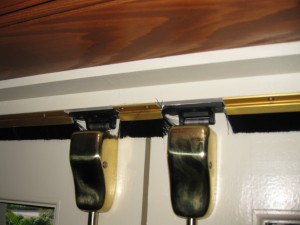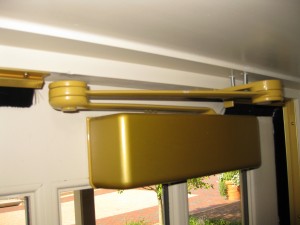One of my (non-hardware industry) friends commented recently that she’s been reading this blog and can’t believe how complicated doors and hardware are. It’s true! There are a thousand ways to screw up a door and I’ve made my share of mistakes over the years, but at this point I often spot problems from across the room while “regular” people continue to walk through the doors without noticing.
The other day while I was talking to the ticket concierge in our hotel, I noticed that the weatherstrip was cut on either side of the closer on the door leading from her office to the exterior. I knew I had to take a photo so I could write a post about closer seals, but I didn’t want to explain my motives to everyone waiting in line behind me so I figured I’d come back later.
When I returned I realized that ALL of the exterior doors in the lobby (and there were A LOT) had this same condition, and even better, I saw the weatherstrip between the vertical rod strikes pictured below. Not only is this a problem for energy efficiency, it doesn’t look very good.
We were actually discussing this application in our office recently, to make sure that what we were specifying was the best solution. We use a continuous solid bar brush weatherstrip which allows the closer shoe and the exit device strikes to be mounted directly to it. This does require some coordination, since the gasketing is 1/4″ thick. The closer moves down by 1/4″, so on the door pictured above the closer would be visible through the glass. Ideally, the top rail of the door would be slightly wider to accommodate the closer. The strikes for the vertical rod panics aren’t a problem, but when rim panics are used, we specify a low profile strike (for example, the Von Duprin 264) so the backset of the exit device doesn’t need to be changed. Some hardware consultants use the solid bar at the top of the door and less expensive weatherstrip for the jambs, which is fine too.
Refer to this post for more information about using this type of gasketing on a fire door assembly.
Read the next post on Chip Falcon’s Road Trip –>
<– Read the previous post on Chip Falcon’s Road Trip
You need to login or register to bookmark/favorite this content.









I prefer to use the brush on the hinge jamb particularly. the brush does not restrict the door from closing as a bulb can sometimes, if it is installed a little too close to the door. Brush is the most forgiving in terms of correct installation.
While I will agree that the seal in the photo is unattractive, a better solution would be a set of stick-on smoke seal such as 2525 or 5050, or a kerfed frame with kerfed weatherstrip. The bar type weatherstrip that is a FAD among some AHC’s is a great solution on paper but causes more problems that it solves.
1. It has to be the installed before the exit device & the door closers. Weatherstrip is the last thing installed on a door during the construction process, especially if the door is painted. No matter how much you try to communicate this point with the field, it generally does not happen because the 1st thing that happens when the doors hit the jobsite is to hang the doors, install the closers & lock the door. Then the door will get a 1st coat of paint & then, because it is an exterior door it will sit until the job is almost complete, then it will get a final coat of paint & the balance of the hardware will be installed, with weatherstrip being the last thing. At this point the weatherstrip will be cut around the strikes & closer brackets.
2. If it is on a single door with a rim device the door has to have a special template. Most hollow metal & hardware suppliers will never pick this up.
3. If it is on a fire rated door has the exit device been tested with the strike mounted on a a bar of aluminum that will melt away?
As AHC’s it is our responsibility to not only write specifications that are clear & correct for the application, but to specify products that will work in real world situations.
I have supplied many projects with the bar type weatherstrip & have written specifications with it. However, in most cases it never is installed correctly, or it ends up being a fight to get it installed correctly. A simple set of smoke seal will generally do the same thing without the expense.
Willie